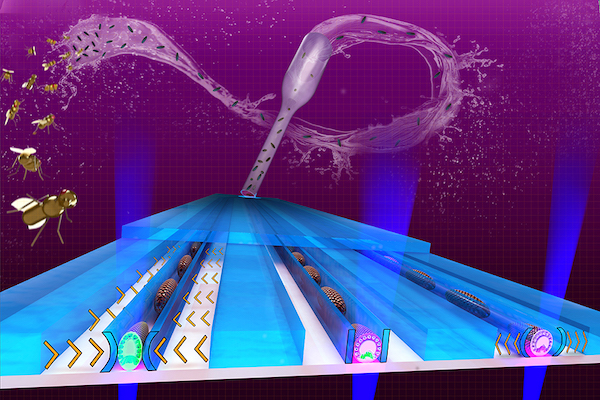Review of microfluidic tools shows flow of innovation
Kirsten Heuring
Aug 24, 2022
“I think oftentimes both fields can become siloed,” said Nolan Frey, a Ph.D. candidate in the Department of Biological Sciences, a member of the Minden Lab and lead author on the review article. “Engineers tend to focus on tool design, whereas biologists focus on the biological systems they are investigating. But in my experience, it's really the transdisciplinary collaboration between the two that allows for breakthroughs.”
Microfluidics involve transporting liquids through tiny channels that modulate fluid pressure to perform different tasks. They are used in a multitude of processes, from transferring ink when using a pen or watching liquid creep from a sample well in a COVID-19 test.

Source: Nolan Frey
An artist's rendition of a microfluidic chamber used in fruit fly experiments.
“Microfluidics, being the science and technology of systems that process or manipulate small amounts of fluids using microscopic channels, enables us to understand and manipulate different aspects of life at the very cellular level,” said Utku Sönmez, a recently graduated Ph.D. candidate in mechanical engineering and a former member of the LeDuc Lab. “This is a very recent and quite powerful ability for biological research.”
In biology, microfluidics is used to manipulate, immobilize, sort and stimulate multicellular organisms. These methods can significantly decrease the amount of human handling necessary in experiments with living organisms, which is less stressful for the organisms and more accessible for human researchers. These methods also can be used on hundreds of organisms at once, saving time and allowing for a large sample size.
Frey uses microfluidics to study Drosophila (fruit fly) embryos, including how mutations affect the organisms’ gene expression and how they adapt to their environments. Microfluidics allow for precise pressure to be applied to the fly embryos, so Frey and fellow researchers can investigate how the embryos sense and respond to physical force.
“Microfluidics is allowing us to look at hundreds of embryos at a time,” said Jonathan Minden, professor of biological sciences. “We can do all sorts of different treatments to the embryos. Now, for the first time, we can learn what general gene expression changes there are.”
Using engineering techniques such as microfluidic systems to tackle biological problems inherently requires an interdisciplinary effort.
Utku Sönmez , Ph.D. alumnus, Mechanical Engineering
Frey and Minden collaborate with researchers from CMU’s College of Engineering, including Sönmez and Philip LeDuc, professor of mechanical engineering, to design the tools necessary for his experiments.
“Using engineering techniques such as microfluidic systems to tackle biological problems inherently requires an interdisciplinary effort,” Sönmez said. “It may not be obvious how an engineering technique can enable new discoveries biological sciences. However, if engineers and biologists communicate more frequently and chat about their interests and findings, there is a good chance that this will lead to unexpected developments.”
While pouring over articles on microfluidics and fruit flies, Frey and Sönmez compiled all the information they learned into a review article. They pitched the article to Nature Communications specifically as a review of how microfluidics can be used in fruit fly experiments. The editors thought the idea was too niche, and they suggested expanding the idea to include other species.
During the beginning and the height of the pandemic, while laboratory experiments were on hold, Frey and Sönmez read papers and wrote the review. LeDuc and Minden mentored them both during the process and served as additional authors.
Frey said one of the most promising aspects of microfluidics is that the necessary tools can be 3D printed with high-resolution equipment. This makes microfluidics less costly than other methods and means they can be created to suit more automated experiments.
“These technologies have gotten to the point where now you’re combining them with other systems, other new technologies like robotics,” Frey said. “It won’t be in the too distant future where we see basic experiments with model organisms — zebrafish, flies, etc. — also having the potential to be automated, and I think microfluidics is going to play a really key role in doing that.”
Frey said he hopes that microfluidics can be used in the new CMU Cloud Lab. These techniques would allow the first academic cloud lab to have a more diverse array of experiments.
“A big part of the reason I came to Carnegie Mellon was that I’m really interested generally in how technologies disrupt different fields, be it in research or more broadly in different aspects of society,” Frey said. “For me it’s been really cool and fun to participate in writing this article and to be part of this research with this team using new technologies on the cutting edge.”
LeDuc emphasized that this type of research is possible because of Carnegie Mellon’s emphasis on interdisciplinary partnerships.
“This type of project is the exact type of work that happens at Carnegie Mellon bringing together researchers from Biological Sciences and Engineering,” LeDuc said. “At some universities, they create centers and institutes to bring these types of researchers together, but at Carnegie Mellon it is in our blood and the way we think about everything.”
Media contacts:
Jocelyn Duffy, Mellon College of Science, jhduffy@andrew.cmu.edu
Lisa Kulick, College of Engineering, lkulick@andrew.cmu.edu